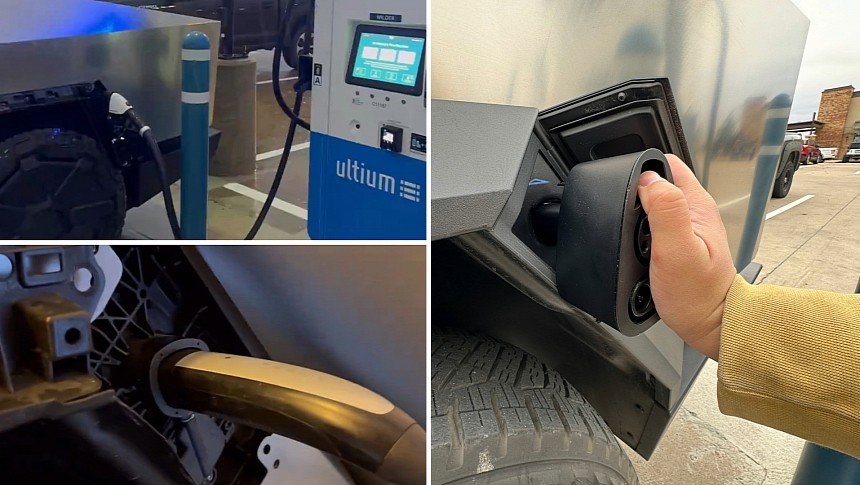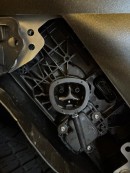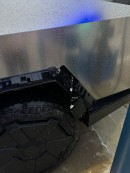The Cybertruck is Tesla's first vehicle featuring an 800-volt architecture, but it can't benefit from it at the moment. Tesla doesn't have public 800-volt Superchargers in North America, and third-party chargers, even when fitted with NACS plugs, are incompatible with the Cybertruck. To make matters worse, the CCS to NACS adapter that Tesla sells doesn't fit the Cybertruck.
Tesla fitted the Cybertruck with an 800-volt electrical system, the first in its lineup. This makes sense, considering the size and weight of the Cybertruck and the high currents needed to flow in and out of the battery pack. Doubling the voltage allows Tesla to halve the current or push more power. Halving the current has significant benefits because thinner wires can be used, lowering both weight and costs. However, the 800-volt architecture comes with challenges of its own, which is why Tesla avoided it in its other EVs.
First, power electronics and inverters need to be upgraded, while improved electrical isolation is also required to withstand the higher voltage. Second, the entire Tesla Supercharger infrastructure is 400 volts only, which makes it more difficult for the Cybertruck to benefit. To go around this, Tesla used a clever trick: split the battery pack in half and connect the two halves in series or parallel, according to the charger's voltage.
Of course, the Cybertruck is designed to offer the optimum performance on an 800-volt charger. Although Tesla advertises a maximum charge power of 250 kW, VP Lars Moravi told influencers who tested the Cybertruck that the electric pickup can accept up to 350 kW when hooked to a V4 Supercharger dispensing 800 volts. This shortens the charging time to 18 minutes for a 15%-85% charge. However, charging at a 400-volt V3 Supercharger takes a lot more than this, as owners discovered.
Since Tesla's V4 Superchargers still deliver only 400 volts, there's no way the Cybertruck could benefit from the faster charger using Tesla's chargers. However, third-party networks have been offering 800-volt chargers for some time. Hopes were high that the Cybertruck could benefit from this before Tesla started deploying 800-volt chargers. However, a recent test shows that this might not be possible after all.
First of all, Tesla's CCS to NACS adapter does not fit the Cybertruck. The reason is that the plastic wheel arches block the charging port, preventing the adapter from being inserted all the way. The only option to make it work is by removing those plastic arches. Still, it doesn't appear that it works this way either, as the Cybertruck and the 800-volt chargers don't communicate to initiate the charging session. This at least happened when Kyle Conner from Out of Spec Reviews tested the Cybertruck charging.
So far, it's unclear whether this is owed to the Cybertruck being incompatible with the CCS charging standard or to shortcomings of the 800-volt CCS protocol. Still, as someone pointed out, NACS is still the same as CCS as far as the communications protocol is concerned, with the only difference being the plug. If the Cybertruck can't charge on CCS stations, it means it might also not work on third-party NACS stations, which still follow the CCS communications protocol. Hopefully, Tesla will provide a software update so that the Cybertruck will not be confined to Superchargers in the future.
First, power electronics and inverters need to be upgraded, while improved electrical isolation is also required to withstand the higher voltage. Second, the entire Tesla Supercharger infrastructure is 400 volts only, which makes it more difficult for the Cybertruck to benefit. To go around this, Tesla used a clever trick: split the battery pack in half and connect the two halves in series or parallel, according to the charger's voltage.
Of course, the Cybertruck is designed to offer the optimum performance on an 800-volt charger. Although Tesla advertises a maximum charge power of 250 kW, VP Lars Moravi told influencers who tested the Cybertruck that the electric pickup can accept up to 350 kW when hooked to a V4 Supercharger dispensing 800 volts. This shortens the charging time to 18 minutes for a 15%-85% charge. However, charging at a 400-volt V3 Supercharger takes a lot more than this, as owners discovered.
Since Tesla's V4 Superchargers still deliver only 400 volts, there's no way the Cybertruck could benefit from the faster charger using Tesla's chargers. However, third-party networks have been offering 800-volt chargers for some time. Hopes were high that the Cybertruck could benefit from this before Tesla started deploying 800-volt chargers. However, a recent test shows that this might not be possible after all.
First of all, Tesla's CCS to NACS adapter does not fit the Cybertruck. The reason is that the plastic wheel arches block the charging port, preventing the adapter from being inserted all the way. The only option to make it work is by removing those plastic arches. Still, it doesn't appear that it works this way either, as the Cybertruck and the 800-volt chargers don't communicate to initiate the charging session. This at least happened when Kyle Conner from Out of Spec Reviews tested the Cybertruck charging.
So far, it's unclear whether this is owed to the Cybertruck being incompatible with the CCS charging standard or to shortcomings of the 800-volt CCS protocol. Still, as someone pointed out, NACS is still the same as CCS as far as the communications protocol is concerned, with the only difference being the plug. If the Cybertruck can't charge on CCS stations, it means it might also not work on third-party NACS stations, which still follow the CCS communications protocol. Hopefully, Tesla will provide a software update so that the Cybertruck will not be confined to Superchargers in the future.
For those wondering, the truck doesn’t know that the powered port is being moved
— Kyle Conner (@itskyleconner) January 3, 2024
We left the port plugged in on our test truck but on another one I tried today I had the port completely removed and the inlet port still allowed charging ^ see video above ^ pic.twitter.com/KAefaOcUwH









